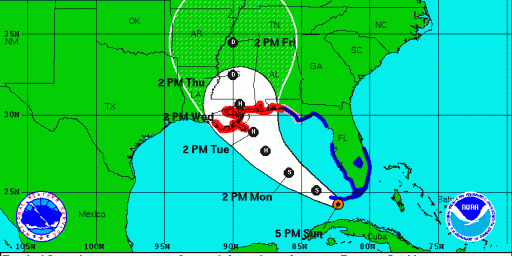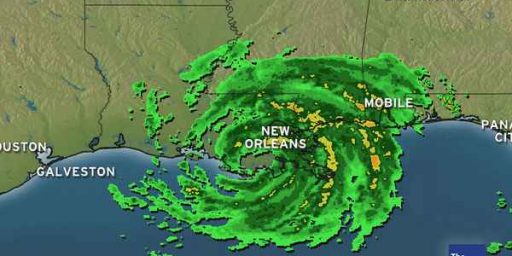Hurricane Rita Could Be Strongest Storm to Hit Texas
Hurricane Rita could be even more powerful than Hurricane Katrina when it makes landfall.
Rita Could Be Strongest Storm to Hit Texas (AP)
Gaining strength with frightening speed, Hurricane Rita swirled toward the Gulf Coast a Category 5, 165-mph monster Wednesday as more than 1.3 million people in Texas and Louisiana were sent packing on orders from authorities who learned a bitter lesson from Katrina.
[…]
Galveston, low-lying parts of Corpus Christi and Houston, and mostly emptied-out New Orleans were under mandatory evacuation orders as Rita sideswiped the Florida Keys and began drawing energy with terrifying efficiency from the warm waters of the Gulf of Mexico. Between 2 a.m. and 4 p.m., it went from a 115-mph Category 2 to a 165-mph Category 5.
Forecasters said Rita could be the most intense hurricane on record ever to hit Texas, and easily one of the most powerful ever to plow into the U.S. mainland. Category 5 is the highest on the scale, and only three Category 5 hurricanes are known to have hit the U.S. mainland — most recently, Andrew, which smashed South Florida in 1992.
Government officials eager to show they had learned their lessons from the sluggish response to Katrina sent in hundreds of buses to evacuate the poor, moved out hospital and nursing home patients, dispatched truckloads of water, ice and ready-made meals, and put rescue and medical teams on standby. An Army general in Texas was told to be ready to assume control of a military task force in Rita’s wake. “We hope and pray that Hurricane Rita will not be a devastating storm, but we got to be ready for the worst,” President Bush said in Washington.
By Wednesday evening, Rita was centered about 580 miles east-southeast of Galveston and was moving west near 13 mph. Forecasters predicted it would come ashore along the central Texas coast between Galveston and Corpus Christi. But with its breathtaking size — tropical storm-force winds extending 350 miles across — practically the entire western end of the U.S. Gulf Coast was in peril, and even a slight rightward turn could prove devastating to the fractured levees protecting New Orleans.
[…]
Galveston, a city of 58,000 on a coastal island 8 feet above sea level, was the site of one of the deadliest natural disasters in U.S. history: an unnamed hurricane in 1900 that killed between 6,000 and 12,000 people and practically wiped the city off the map.
The last major hurricane to strike the Houston area was Category-3 Alicia in 1983. It flooded downtown Houston, spawned 22 tornadoes and left 21 people dead. In Houston, the state’s largest city and home to the highest concentration of Katrina refugees, the area’s geography makes evacuation particularly tricky. While many hurricane-prone cities are right on the coast, Houston is 60 miles inland, so a coastal suburban area of 2 million people must evacuate through a metropolitan area of 4 million people where the freeways are often clogged under the best of circumstances.
Having two once-in-a-generation storms hitting the same part of the country within a month is incredible.






must be Bush’s fault
Beat me to it, Kenny. I blame Bushitler Zionazi AWOL coke-head Halliburton!